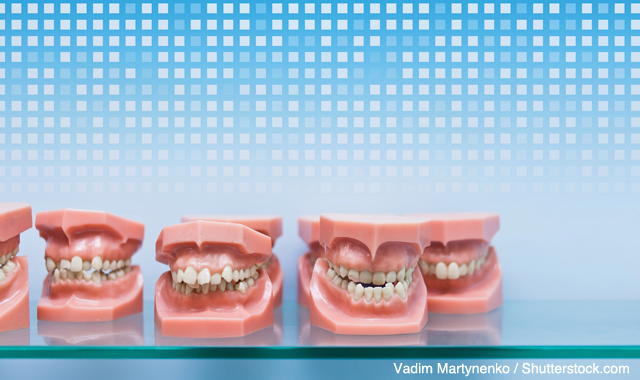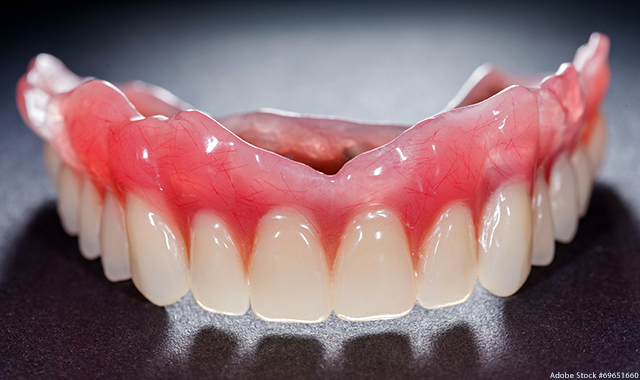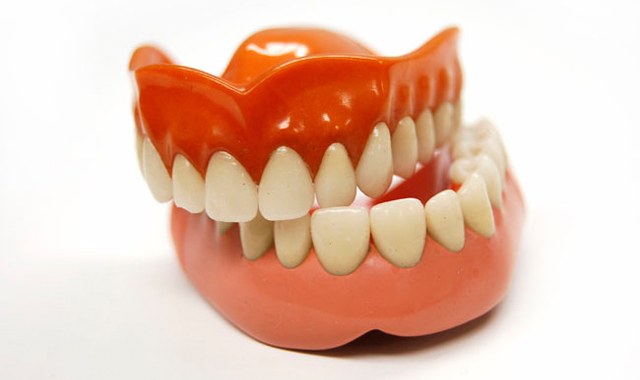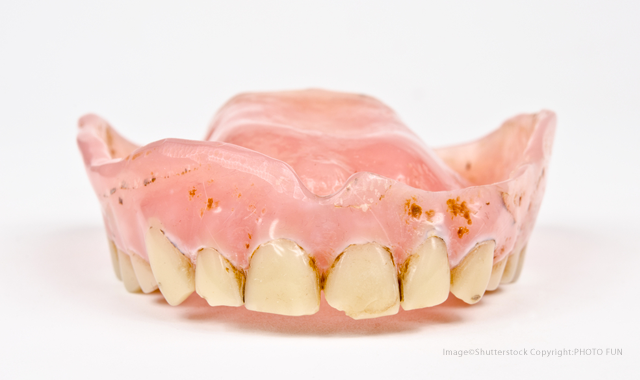5 biggest patient complaints about dentures – and how to solve them
Our experts share the most common complaints they hear from patients when it comes to wearing dentures.
Here at Dental Products Report, we spoke to denture experts to discover what are some common complaints patients have about their dentures.

According to our experts, here are the five biggest complaints patients have about dentures - and how to solve them.
Trending article: The biggest evolution in dentures is almost here
Click through the slides to learn more.


1. “I can’t eat with my denture.”
Dan Elfring, CDT, has been making dentures for more than a decade. He says that conventional dentures often result in a reduced biting force. Patients can’t bite as hard, and it creates problems eating certain types of foods.
Also, the plastic on the maxillary covers the whole palette for suction, which reduces the effects of their taste buds. Elfring says that patients say they feel as if they lost their taste buds and they can’ tell if food is hot or cold.
Since there are no implants used with conventional dentures, the bones will continue to deteriorate. As the bone deteriorates, the soft tissue changes and the denture doesn’t fit as well. The denture will then move around and make sore spots. Elfring says for all these reasons, the denture has to be relined periodically.
More from the author: Increasing FDA involvement in CAD/CAM dental restorations
The lower denture is also problematic because the tongue and the floor of the mouth move, and it wants to dislodge every time the patient moves his or her tongue. Moreover, as the bone resorbs, the lower ridge gets flatter, making it more difficult for a lower denture to stay in place.
“Then they are flopping all around. That’s when patients come to us for implants, and then we secure it,” Elfring says.
Elfring estimates only around 30 percent of his lab’s patients have conventional dentures. Pickle Prosthodontics, which is where Elfring is the in-house lab technician, does mostly implant-related solutions. If patients complain about bite force, then Elfring says implants are the first level of solution.
“Then we can retain it, and the bite force is directed to the bone and not the soft tissue. The implants also help to stop bone loss,” Elfring says. “There are lots of advantages of putting two to four implants per arch. We would try to talk them into that.”
Implants would also help with taste and hot and cold sensitivity that patients lose with conventional dentures. By using six implants on the maxillary arch, the palette is freed from the acrylic denture base that obstructs patients’ taste buds and nerve endings.
Every patient doesn’t opt for implants, however, for a few different reasons. Usually, the cost is an issue since implants are more of an investment than conventional dentures. Another reason could be the patient is in poor health and doesn’t want to put the stress on this or her body with the surgery. Also, some patients have too many medications they take that could interfere with the procedure and recovery.
However, patients going with implant-retained dentures often have great results. Pickle Prosthodontics received a letter for a hybrid case where the doctor extracted teeth, treated the infection and did an all-on-four procedure. The patient can eat better and his health is improving.
“The patient is going to try to get off of the blood pressure medication now,” Elfring says. “Nutrition equates to good health. Being able to eat proper foods for nutrition is a bigger deal than so many of us think about.”



2. “My denture doesn’t fit.”
Many denture patients think their dentures don’t fit because the denture moves in their mouth when they chew. This movement can make it difficult to eat and cause sore spots due the denture causing friction on the mucosa. To correct the denture fit, patients come in for an adjustment, which results in chair time for which the dental professional usually doesn’t bill for. If billing does occur, then patients typically stop receiving treatment and use denture adhesive.
Many times, however, dentures can fit and function properly. Marc Wagenseil, CDT, DD, is a denturist in Alberta, Canada, and an international lecturer for VITA North America and VITA Zahnfabrik in Europe. He believes the perceived fit issues stem from a few critical aspects of denture teeth design and construction.
Denture teeth are historically made flatter and with less anatomy than natural teeth. Wagenseil says the teeth were designed this way to prevent rocking of the denture base when the patient chewed.
Working and balancing describe how denture professionals use bilateral balanced occlusion to stabilize the denture when the patient chews. However, Wagenseil says denture design forgets the concept of freedom in centric or the wiggle room our natural teeth have.
Related reading: How digital dentistry and 3D printing are changing dentures
“Our natural teeth and temporomandibular joint are not locked upon closing in centric,” he says. “Both can move horizontally, so to speak. When one holds their teeth together in centric, they can wiggle them while holding them together. This is the freedom in centric principle. We require denture teeth that can wiggle a little bit.”
Per Wagenseil, not all denture teeth incorporate these occlusal or centric “landmarks.” He prefers to use VITA premium denture teeth, which incorporate the freedom in centric design. He says denture teeth that don’t incorporate freedom in centric cause the denture “waggle” on the gum when the patient chews. The movement gives the patient the mistaken impression that the denture doesn’t fit.
Another area of improvement for fit (and also bite force) is to incorporate lingualized occlusion into the denture design. Wagenseil says it helps people chew like they do with their natural teeth.
“Because lingualized occlusion is more of a mortar and pestle type of approach, it crushes food like natural teeth do,” Wagenseil explains.
Since adopting his denture designs to incorporate lingualized occlusion with freedom in centric functionality, Wagenseil says he doesn’t have as many patients complaining about the fit as before, and the use of adhesive and soft liners has also greatly diminished.
Wagenseil says he consistently delivers dentures with zero to one adjustment, down from the average adjustment rate of two to five.
“You have to look at the economic value of that. If you estimate $400/hour for an American general dentist and a patient comes in for two adjustments, and let’s say they take 30 minutes at a time, that’s $400 off the profit that the office lost. That’s a lot of money,” Wagenseil says. “It is more than what denture tooth is the cheapest. It has to function in relation to the human chewing cycle. The savings are in your adjustment time and costs, which more than offset the denture tooth cost.”
Wagenseil lectures about these concepts to try to help other denture professionals do the same for their patients.
“As a denture professional, we change lives. Patients trust us to help with their chewing ability. Eating is life,” Wagenseil says. “We change lives because we are able to help rehabilitate someone’s chewing cycle. Since incorporating freedom in centric denture teeth, I am able to do so with better predicable results and far less issues.”



3. “My dentures don’t look natural.”
Wagenseil says patients want natural-looking dentures, not artificial-looking ones. Ideally, patients don’t want anyone to notice they’re wearing dentures.
“Sure, they want a light color because we are conditioned to that,” he says. “But it should still look like enamel or a real tooth.”
Real teeth have opalescence and fluorescence. Fluorescence, in particular, gives teeth vitality because it reflects the phosphorous in our teeth.
Trending article: How digital technology has taken the dental industry by storm
“This phenomenon happens under incandescent, fluorescent or natural lighting. Teeth should have that fluorescence, that vitality, in them and not all denture teeth do,” Wagenseil says.
Wagenseil adds that people will always pick function over esthetics. While they don’t want Chiclet-type teeth, it’s more important that they function.
“When choosing a denture tooth, provide one which incorporates both; they do exist!” he says.
Achieving both high-functioning and natural-looking dentures is the best-case scenario. Wagenseil recommends working with denture materials that have the proper appearance regarding color and natural light reflection and function harmoniously with the chewing system.



4. “Is my denture made from brand-name materials?”
Justin Marks, CDT, and founder and CEO of Arfona, worked in customer service for Valplast, a manufacturer of flexible denture material typically used for partial dentures. His job in the call center gave him an opportunity to interact with patients directly.
“When working with customer service, I was in a unique position to speak with patients. Most dental lab technicians are not,” Marks explains.
Marks says the majority of the call volume was patients who wanted a name brand material for their denture or partial denture but didn’t get confirmation the dentist used it. While it isn’t always the case, Marks says sometimes the patients want brand names for their denture materials.
More from the author: The top 10 things that scare patients the most
“I might catch some flak from dentists for saying that, but patients do more research online than they used to,” Marks says. “It’s not to say that the patients are right, but they are more aware of materials heading into the dental clinic than they were in the past, and there is nothing wrong with that. So, if they are looking for a specific brand or procedure, at the end of the day, they are entitled to ask for it.”
Sometimes laboratories substitute materials and don’t inform the dentist. Marks says the lab could have many reasons for the switch, but usually it’s because of price or familiarity with one material over another.
Marks suggests knowing which materials the lab uses to ensure there are no substitutions or vulnerabilities in the supply chain. Also, the dentist should ask what the denture is made of if the lab doesn’t disclose this information, especially when the patient asks for a specific denture material brand.
Marks also says to educate patients when the doctor or lab prefers a different material than what the patient wants.
“At the end of the day, the dentist is writing the prescription, and it is his or her professional responsibility,” Marks says. “Make sure you discuss everything with the patient.



5. “I can’t get used to this thing.”
Dr. Paresh Patel, DDS, a private practice dentist in Lenore, North Carolina, who has practiced for just over 20 years, says that some patients just can’t get used to a denture. He has patients who come in with their removable denture in their pocket or their pocketbook.
“So you ask, ‘Do you wear this?’ They will answer, ‘Only when I go out in public,’ or ‘only when my wife makes me wear it,’” Dr. Patel says.
Dr. Patel says that for many patients, having a denture is an unknown experience. Some patients can adapt, while others can’t.
“It’s a drastic change,” Dr. Patel says. “You have a hard time as a dentist and a healthcare professional explaining to somebody what that experience might be because it’s unlike teeth. Especially if they haven’t had a partial, they don’t know what they don’t know about how something is going to feel in their mouth.”
Related reading: What you need to know about the evolution of dentures
Dr. Patel imagines the same principles apply to sleep apnea and CPAP machines. While a large population might benefit from a CPAP, they might not like using it.
“Maybe they are a side or stomach sleeper, or maybe they are claustrophobic. All of these things bring down the acceptance and the ability for people to adapt to that kind of prosthesis as well,” Dr. Patel says.
Dr. Patel says everyone has his or her own unique experience and it is what it is. He has heard all of the following complaints from patients:
- It’s too big.
- Are you sure this is mine?
- I can’t talk.
- I salivate too much.
- It moves around.
- It creates a sore spot.
- I don’ t like how it makes my lip pooch out.
- My tongue doesn’t have enough space.
- I can’t taste my food.
“Certainly, there have been times when we give a patient a denture and we never see them again,” Dr. Patel says. “Sometimes you can’t even insert the denture or give the patient a denture without them gagging or simply pushing it out of their mouth with their tongue.”
Dr. Patel says that for those people who can’t adapt to wearing removable dentures and who can afford something else, he encourages them to consider implant-retained dentures. However, in most cases where budget is an issue, he encourages them to keep trying to get used to it and wear it more often.
“It’s a prosthetic just like any prosthesis,” Dr. Patel says. “We have people who lose limbs, and we spend a lot of time making these prostheses. Some people can learn to walk with them, and some people learn to walk but get sore spots where the prosthesis is attached to their amputated limb. The denture is as close to teeth as we can give them that is not attached to an implant."
